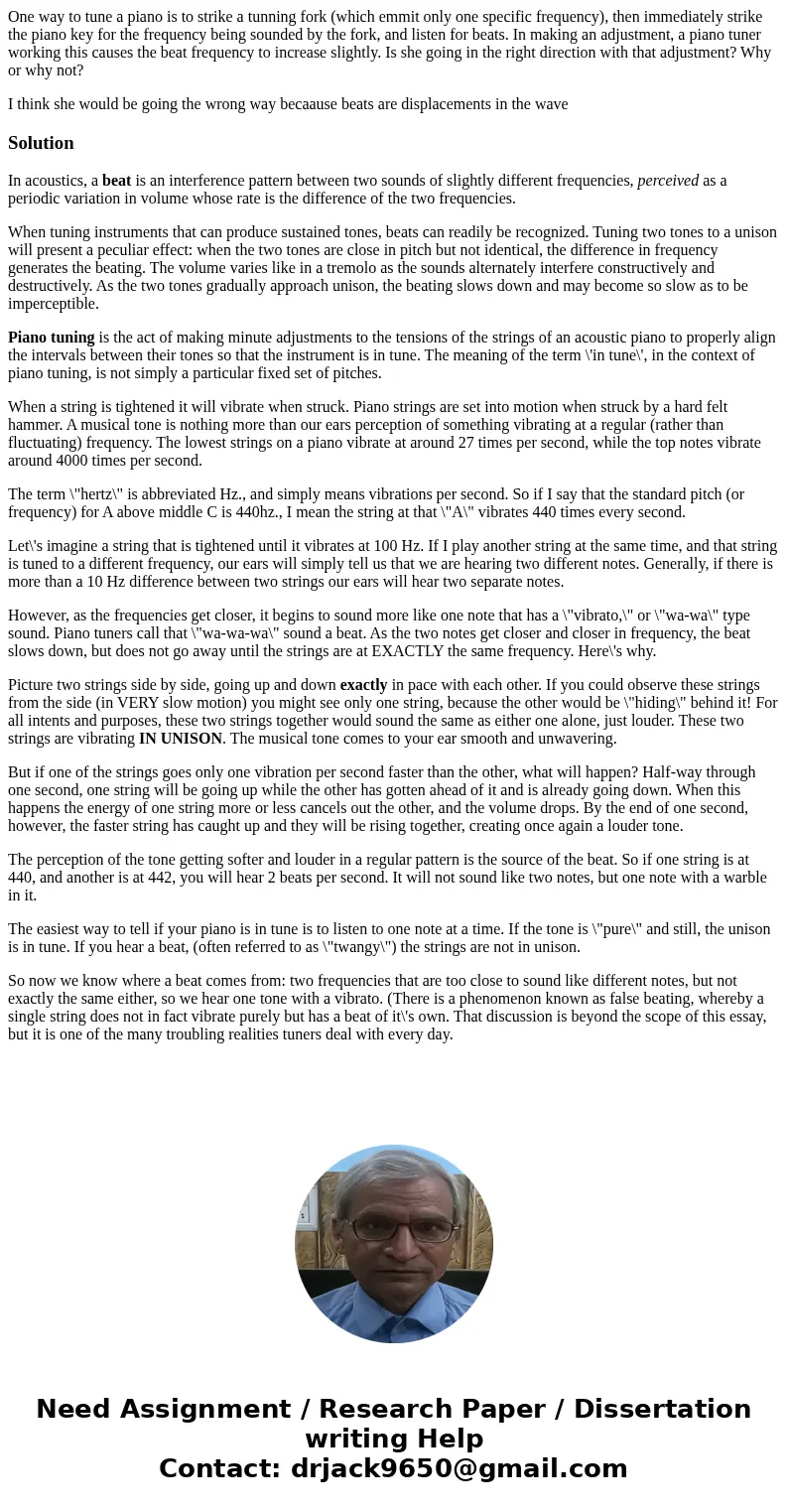One way to tune a piano is to strike a tunning fork which em
One way to tune a piano is to strike a tunning fork (which emmit only one specific frequency), then immediately strike the piano key for the frequency being sounded by the fork, and listen for beats. In making an adjustment, a piano tuner working this causes the beat frequency to increase slightly. Is she going in the right direction with that adjustment? Why or why not?
I think she would be going the wrong way becaause beats are displacements in the wave
Solution
In acoustics, a beat is an interference pattern between two sounds of slightly different frequencies, perceived as a periodic variation in volume whose rate is the difference of the two frequencies.
When tuning instruments that can produce sustained tones, beats can readily be recognized. Tuning two tones to a unison will present a peculiar effect: when the two tones are close in pitch but not identical, the difference in frequency generates the beating. The volume varies like in a tremolo as the sounds alternately interfere constructively and destructively. As the two tones gradually approach unison, the beating slows down and may become so slow as to be imperceptible.
Piano tuning is the act of making minute adjustments to the tensions of the strings of an acoustic piano to properly align the intervals between their tones so that the instrument is in tune. The meaning of the term \'in tune\', in the context of piano tuning, is not simply a particular fixed set of pitches.
When a string is tightened it will vibrate when struck. Piano strings are set into motion when struck by a hard felt hammer. A musical tone is nothing more than our ears perception of something vibrating at a regular (rather than fluctuating) frequency. The lowest strings on a piano vibrate at around 27 times per second, while the top notes vibrate around 4000 times per second.
The term \"hertz\" is abbreviated Hz., and simply means vibrations per second. So if I say that the standard pitch (or frequency) for A above middle C is 440hz., I mean the string at that \"A\" vibrates 440 times every second.
Let\'s imagine a string that is tightened until it vibrates at 100 Hz. If I play another string at the same time, and that string is tuned to a different frequency, our ears will simply tell us that we are hearing two different notes. Generally, if there is more than a 10 Hz difference between two strings our ears will hear two separate notes.
However, as the frequencies get closer, it begins to sound more like one note that has a \"vibrato,\" or \"wa-wa\" type sound. Piano tuners call that \"wa-wa-wa\" sound a beat. As the two notes get closer and closer in frequency, the beat slows down, but does not go away until the strings are at EXACTLY the same frequency. Here\'s why.
Picture two strings side by side, going up and down exactly in pace with each other. If you could observe these strings from the side (in VERY slow motion) you might see only one string, because the other would be \"hiding\" behind it! For all intents and purposes, these two strings together would sound the same as either one alone, just louder. These two strings are vibrating IN UNISON. The musical tone comes to your ear smooth and unwavering.
But if one of the strings goes only one vibration per second faster than the other, what will happen? Half-way through one second, one string will be going up while the other has gotten ahead of it and is already going down. When this happens the energy of one string more or less cancels out the other, and the volume drops. By the end of one second, however, the faster string has caught up and they will be rising together, creating once again a louder tone.
The perception of the tone getting softer and louder in a regular pattern is the source of the beat. So if one string is at 440, and another is at 442, you will hear 2 beats per second. It will not sound like two notes, but one note with a warble in it.
The easiest way to tell if your piano is in tune is to listen to one note at a time. If the tone is \"pure\" and still, the unison is in tune. If you hear a beat, (often referred to as \"twangy\") the strings are not in unison.
So now we know where a beat comes from: two frequencies that are too close to sound like different notes, but not exactly the same either, so we hear one tone with a vibrato. (There is a phenomenon known as false beating, whereby a single string does not in fact vibrate purely but has a beat of it\'s own. That discussion is beyond the scope of this essay, but it is one of the many troubling realities tuners deal with every day.

 Homework Sourse
Homework Sourse